Why Catalan Independence doesn’t affect the Madrid property market
In early 2017, savvy investors predicted that Madrid and Barcelona would be “the hottest European real estate markets”. Before the October 1, 2017 independence referendum in Catalonia many people didn’t know if Barcelona or Madrid was the best city for property investment. Post referendum the answer is clear: Purchasing Madrid property is the best way to invest in Europe’s hottest real estate market.
Madrid is a lovely, sunny city that boasts the best lifestyle of any European capital. From a financial perspective it presents an even more compelling story. Over the past ten years the government of Madrid has consistently made steps to attract foreign investment by lowering taxes and investing in infrastructure. These results have paid off: almost half of Foreign Direct Investment (FDI) into Spain is based in Madrid. Conversely, businesses are fleeing Catalonia. Post referendum, over eight hundred businesses have announced they are moving their headquarters from Catalonia to other regions in Spain. The number grows every day. Many of them are choosing to move to the safety of Madrid, including big corporations like Sabadell.
The history of Catalan independence
The Catalan independence movement has been going on for quite some time. It started in 1922 (read about the history of the Catalan independence movement here). In 2006 the resistance movement gathered new momentum when Catalonia was granted autonomy. For years investors have worried about the stability of the political situation in the region. Since the recent referendum, many people have called and written us, asking our opinion about the situation and if Madrid is a better city for property investment. The truth is this:
- Catalonia will continue to be unstable for years to come.
- Catalonia has experienced severe capital flight. As of late October, 2017, over 1,800 firms have left Catalonia.
- The Madrid property market is insulated from the Catalan situation.
- Madrid is definitely a better city for property investment, for reasons that have little to nothing to do with the Catalan independence movement.

Although international press makes the Catalan situation sound alarming, the truth is the opposite. Madrid is unaffected: the only sign of the movement are the tens of thousands of Spanish flags hanging from the balconies of Madrid, showing support of the Government of Spain.
Three reasons why Madrid is the best city for property investment
Madrid is the best city for property investment, however this is not a new phenomenon. Twenty years ago Barcelona was the clear winner. It had a much better infrastructure, better tourist facilities and a more favorable economy. The leaders of Madrid saw this and have consistently taken strong, unrelenting steps to make Madrid a better place to visit, live and invest.
1— Barcelona real estate is over valued
Prior to the referendum, many investors were drawn to Barcelona. It has the sea, striking architecture and innovative cuisine. It magnetizes tourists. However, it’s popularity came at a price. According to Idealista, a Spanish real estate site, in 3Q16 Madrid residential property averaged €2,902 per square meter. The price for residential property in Barcelona averaged €3,667 per square meter over the same time period. That’s a 21% difference.
Is Barcelona real estate worth that premium? We don’t think so. Especially now, since the local government doesn’t grant any new Airbnb licenses in the center. This law came about because the residents of Barcelona complained about the noise, the through traffic, etc. It is endemic of a bigger problem: Barcelona is trying to curb the effects of tourism. That might be nice on Saturday nights for people that want to spend a quiet evening relaxing on an outdoor terrace, but economically speaking it is biting the hand that feeds it.
2— Madrid has relentlessly made changes to make it investor friendly
Madrid has the best governance in Spain and is quickly becoming a model for other European cities. Its leaders have actively implemented steps to make it friendly for foreign investors.
“The Spanish Government aims to make Spain increasingly attractive to foreign investors.” – Spanish Prime Minister Mariano Rajoy
Increased infrastructure investment
Madrid arguably has the best infrastructure in Europe, and one of the best in the world. The Metro and Cercanías Madrid (the light rail system) are clean, affordable and extremely reliable. To put it in perspective, the service during last summer’s Metro strike was still better than that of NYC’s MTA on a good day, at less than a third of the price per ticket. And there are no rats in the tunnels or on the platforms!
Madrid has buses that run 24/7, cars are limited in the city center and there are future plans to ban cars altogether from the city center. The airport Barajas has been thoroughly modernized and is extremely efficient. Lines at passport control are a fraction of the length as the queues at Heathrow, Gatwick or Charles de Gaulle.
This excellent infrastucture has stimulated business interest in the city. Madrid is now the second city in Europe for hosting trade fairs after Frankfurt.
Encouragement of entreprenurial activity
Initially, the government of Madrid outlawed Uber and people worried that other sharing economy firms, like Airbnb and Lyft, would be regulated. However, the government has done a rethink of this. Uber has been allowed back into Madrid. Airbnb is allowed and no attempts have been made to regulate it.
The government has made great attempts to encourage entreprenuership. A special Entreprenur Visa has been created to attract foreign innovators. The City of Madrid gives free co-working space to foreign entreprenurs that move to the city.

With its image tarnished by the Catalan independence movement, Madrid scores higher than Barcelona on every measure for positive FDI except one. The number 7 ranked port.
Lower taxes
The City of Madrid has pulled off the amazing feat of lowering taxes and reducing debt. Business taxes, property taxes and taxes on property purchases have all been lowered over the past ten years. The ITP, which is the tax on second hand property purchases, is now 6%, the lowest in Spain. In comparison, Barcelona’s ITP is 10%. Madrid leaders have governed so effectively the past ten years they have also managed to decrease the City’s debt by 27%.

Have theses strategies encouraged investment?
Yes! According to recent statistics, Foreign Direct Investment (FDI) in Spain overwhelmingly flows through Madrid. Almost half of all Spanish FDI is in the city, and Madrid continues to grow this share. If you wish to delve into this more deeply, we recommend this third party research: Madrid region acts as FDI magnet.

3— The future looks even brighter
These trends are expected to continue. People are seeing the effects of good governance. The City of Madrid is growing vibrantly while other parts of Spain still grapple with high unemployment and sluggish to no growth. The policies have been so effective there is no reason to expect that they won’t continue.
Madrid has been a real success story. It is insulated from, and stands to benefit financially from the Catalan independence movement. It continues to attract foreign investment and every day it becomes more tourist friendly. Concurrently, Barcelona is going in the opposite direction. It’s becoming less welcoming to tourists and increasingly expensive. It will continue to be plagued by the regional instability caused by the Catalan movement.
We at Moving2Madrid like to think of Madrid as the Spanish Milan. Very few would argue that Milan is more beautiful than Rome. Rome has thousands of years of history, is extremely close to the sea and has some of the best food in the world. Northern Milan was the ugly, albeit economically efficient, step-sister. Rome used to attract more visitors but not anymore. Hotel taxes have gone up, the infrastructure continues to deteriorate and tourists have stopped coming. Meanwhile Milan has restored monuments, banned cars in certain places and kept its hotels and Airbnbs relatively unregulated. The results have paid off: for the third year in a row, Milan attracted more visitors than Rome in 2016.
If you want to learn more about why Madrid is the best city for property investment, or to learn about how to purchase Madrid real estate, get in touch with us today.
Posted on 13 October, 2017 by Pierre-Alban Waters in How to invest, New? Start Here






[…] The City of Madrid’s Government has been streamlining regulation, lowering taxes and improving…. This is attracting foreign investment and leading to upward pressure on housing prices. […]
[…] experience, there are sixteen Michelin star restaurants to chooose from (as opposed to just five in Barcelona). These range from the innovative, three star DiverXO with a circus like atmosphere that does […]
[…] The referendum in December, 2017 did little to resolve the issue of Catalonian independence. As a result, firms are still leaving Catalonia for other parts of Spain. Even the iconic Cava producer Codorníu, founded in 1551, has announced a move to La Rioja. At the end of December, 2017, there was only one Catalan domiciled company listed on Spain’s blue-chip Ibex 35 stock market index. The bulk of these companies are relocating to Madrid, which will put upward pressure on Madrid real esta…. […]
[…] The situation in Cataluña strongly benefits Madrid. Over 1,800 businesses, even large banks such as Caixa and Sabadell, have left the region. Many of these are moving to the capital. This will drive economic growth in the City of Madrid and bolster the real estate market. To learn more about the situation in Cataluña, read Why Catalan independence doesn’t affect the Madrid property market. […]